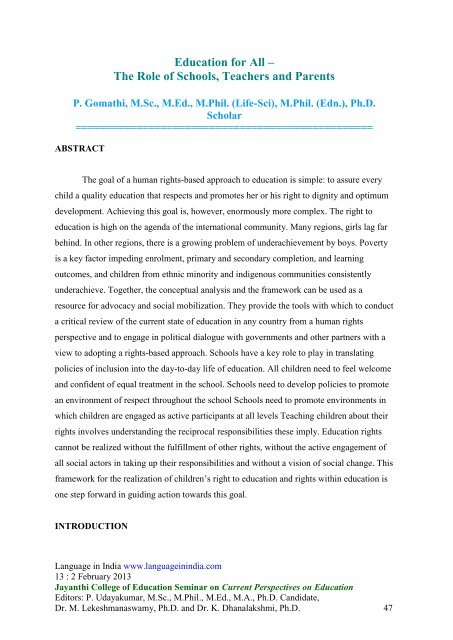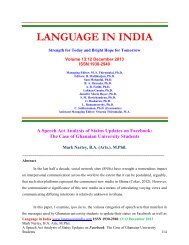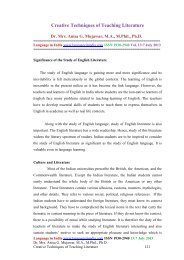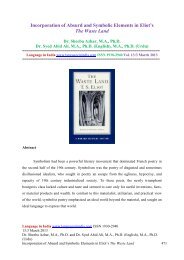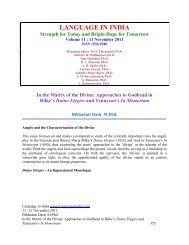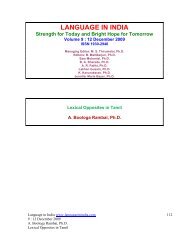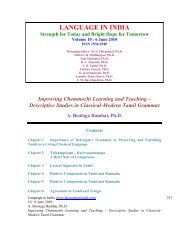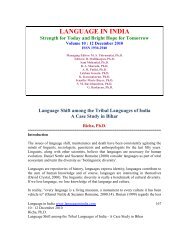Education for All – The Role of Schools ... - Language in India
Education for All – The Role of Schools ... - Language in India
Education for All – The Role of Schools ... - Language in India
Create successful ePaper yourself
Turn your PDF publications into a flip-book with our unique Google optimized e-Paper software.
<strong>Education</strong> <strong>for</strong> <strong>All</strong> <strong>–</strong><br />
<strong>The</strong> <strong>Role</strong> <strong>of</strong> <strong>Schools</strong>, Teachers and Parents<br />
P. Gomathi, M.Sc., M.Ed., M.Phil. (Life-Sci), M.Phil. (Edn.), Ph.D.<br />
Scholar<br />
=================================================<br />
ABSTRACT<br />
<strong>The</strong> goal <strong>of</strong> a human rights-based approach to education is simple: to assure every<br />
child a quality education that respects and promotes her or his right to dignity and optimum<br />
development. Achiev<strong>in</strong>g this goal is, however, enormously more complex. <strong>The</strong> right to<br />
education is high on the agenda <strong>of</strong> the <strong>in</strong>ternational community. Many regions, girls lag far<br />
beh<strong>in</strong>d. In other regions, there is a grow<strong>in</strong>g problem <strong>of</strong> underachievement by boys. Poverty<br />
is a key factor imped<strong>in</strong>g enrolment, primary and secondary completion, and learn<strong>in</strong>g<br />
outcomes, and children from ethnic m<strong>in</strong>ority and <strong>in</strong>digenous communities consistently<br />
underachieve. Together, the conceptual analysis and the framework can be used as a<br />
resource <strong>for</strong> advocacy and social mobilization. <strong>The</strong>y provide the tools with which to conduct<br />
a critical review <strong>of</strong> the current state <strong>of</strong> education <strong>in</strong> any country from a human rights<br />
perspective and to engage <strong>in</strong> political dialogue with governments and other partners with a<br />
view to adopt<strong>in</strong>g a rights-based approach. <strong>Schools</strong> have a key role to play <strong>in</strong> translat<strong>in</strong>g<br />
policies <strong>of</strong> <strong>in</strong>clusion <strong>in</strong>to the day-to-day life <strong>of</strong> education. <strong>All</strong> children need to feel welcome<br />
and confident <strong>of</strong> equal treatment <strong>in</strong> the school. <strong>Schools</strong> need to develop policies to promote<br />
an environment <strong>of</strong> respect throughout the school <strong>Schools</strong> need to promote environments <strong>in</strong><br />
which children are engaged as active participants at all levels Teach<strong>in</strong>g children about their<br />
rights <strong>in</strong>volves understand<strong>in</strong>g the reciprocal responsibilities these imply. <strong>Education</strong> rights<br />
cannot be realized without the fulfillment <strong>of</strong> other rights, without the active engagement <strong>of</strong><br />
all social actors <strong>in</strong> tak<strong>in</strong>g up their responsibilities and without a vision <strong>of</strong> social change. This<br />
framework <strong>for</strong> the realization <strong>of</strong> children’s right to education and rights with<strong>in</strong> education is<br />
one step <strong>for</strong>ward <strong>in</strong> guid<strong>in</strong>g action towards this goal.<br />
INTRODUCTION<br />
<strong>Language</strong> <strong>in</strong> <strong>India</strong> www.language<strong>in</strong><strong>in</strong>dia.com<br />
13 : 2 February 2013<br />
Jayanthi College <strong>of</strong> <strong>Education</strong> Sem<strong>in</strong>ar on Current Perspectives on <strong>Education</strong><br />
Editors: P. Udayakumar, M.Sc., M.Phil., M.Ed., M.A., Ph.D. Candidate,<br />
Dr. M. Lekeshmanaswamy, Ph.D. and Dr. K. Dhanalakshmi, Ph.D. 47
<strong>The</strong> goal <strong>of</strong> a human rights-based approach to education is simple: to assure every<br />
child a quality education that respects and promotes her or his right to dignity and optimum<br />
development. Achiev<strong>in</strong>g this goal is, however, enormously more complex. <strong>The</strong> right to<br />
education is high on the agenda <strong>of</strong> the <strong>in</strong>ternational community. It is affirmed <strong>in</strong> numerous<br />
human rights treaties and recognized by governments as pivotal <strong>in</strong> the pursuit <strong>of</strong><br />
development and social trans<strong>for</strong>mation. This recognition is exemplified <strong>in</strong> the <strong>in</strong>ternational<br />
goals, strategies and targets that have been set dur<strong>in</strong>g the past 20 years. <strong>The</strong> Millennium<br />
Development Goals, established <strong>in</strong> 2000, the world’s governments committed to achiev<strong>in</strong>g<br />
universal access to free, quality and compulsory primary education by 2015. In ‘A World Fit<br />
<strong>for</strong> Children’, the outcome document from the United Nations General Assembly Special<br />
Session on Children <strong>in</strong> 2002, governments reaffirmed these commitments and agreed to a<br />
range <strong>of</strong> strategies and actions to achieve them. More ambitious targets have been<br />
established <strong>in</strong> many regions. <strong>Education</strong> was recognized as a human right, only a m<strong>in</strong>ority <strong>of</strong><br />
the world’s children had access to any <strong>for</strong>mal education; now a majority <strong>of</strong> them go to<br />
school, and participation <strong>in</strong> <strong>for</strong>mal education beyond the elementary stages has <strong>in</strong>creased. In<br />
many regions, girls lag far beh<strong>in</strong>d. In other regions, there is a grow<strong>in</strong>g problem <strong>of</strong><br />
underachievement by boys. Poverty is a key factor imped<strong>in</strong>g enrolment, primary and<br />
secondary completion, and learn<strong>in</strong>g outcomes, and children from ethnic m<strong>in</strong>ority and<br />
<strong>in</strong>digenous communities consistently underachieve.<br />
Although there are notable and creative exceptions to the rule, there is grow<strong>in</strong>g<br />
recognition that the approaches adopted to achieve the goals <strong>of</strong> universal access and quality<br />
education are <strong>in</strong>adequate. <strong>The</strong>re has been a failure to acknowledge the complexity <strong>of</strong> the<br />
barriers imped<strong>in</strong>g children’s access to school, to listen to the concerns expressed by children<br />
themselves concern<strong>in</strong>g their education, to build a culture <strong>of</strong> education <strong>in</strong> which all children<br />
are equally respected and valued, to engage parents and local communities <strong>in</strong> support<strong>in</strong>g<br />
education, to embrace a holistic approach to education, to address children’s rights <strong>in</strong><br />
education or to embed schools as vibrant centres <strong>for</strong> community action and social<br />
development.<br />
Adopt<strong>in</strong>g a rights-based approach to education is not a panacea. It does pose some<br />
challenges <strong>–</strong> <strong>for</strong> example, the need to balance the claims <strong>of</strong> different rights holders and<br />
<strong>Language</strong> <strong>in</strong> <strong>India</strong> www.language<strong>in</strong><strong>in</strong>dia.com<br />
13 : 2 February 2013<br />
Jayanthi College <strong>of</strong> <strong>Education</strong> Sem<strong>in</strong>ar on Current Perspectives on <strong>Education</strong><br />
Editors: P. Udayakumar, M.Sc., M.Phil., M.Ed., M.A., Ph.D. Candidate,<br />
Dr. M. Lekeshmanaswamy, Ph.D. and Dr. K. Dhanalakshmi, Ph.D. 48
address potential tensions between the realization <strong>of</strong> different rights or between rights and<br />
responsibilities. Nevertheless, consistent adherence to its core pr<strong>in</strong>ciples can help meet the<br />
education goals <strong>of</strong> governments, parents and children. It demands the creation <strong>of</strong> strategies<br />
to reach all children, <strong>in</strong>clud<strong>in</strong>g the most marg<strong>in</strong>alized. It empowers communities, parents<br />
and other stakeholders to claim their rights, <strong>in</strong>sist that these be fully implemented and, when<br />
necessary, seek their en<strong>for</strong>cement <strong>in</strong> national courts. <strong>Education</strong> <strong>for</strong> <strong>All</strong> addresses the<br />
educational rights <strong>of</strong> children rather than adults. Not only does it focus on the right to<br />
education, it also addresses rights with<strong>in</strong> education, <strong>in</strong>clud<strong>in</strong>g human rights education.<br />
ROLE OF SCHOOLS<br />
INTRODUCING PRACTICAL MEASURES FOR INCLUSION<br />
<strong>Schools</strong> have a key role to play <strong>in</strong> translat<strong>in</strong>g policies <strong>of</strong> <strong>in</strong>clusion <strong>in</strong>to the day-today<br />
life <strong>of</strong> education. <strong>All</strong> children need to feel welcome and confident <strong>of</strong> equal treatment <strong>in</strong><br />
the school. <strong>Schools</strong> need to promote an atmosphere <strong>of</strong> respect <strong>for</strong> all children. <strong>The</strong>y should<br />
<strong>in</strong>stigate a culture that ensures that no bias is tolerated that favors or discrim<strong>in</strong>ates aga<strong>in</strong>st<br />
any learner or group <strong>of</strong> learners <strong>–</strong> whether <strong>in</strong> respect <strong>of</strong> admission procedures, treatment <strong>in</strong><br />
the classroom, opportunities <strong>for</strong> learn<strong>in</strong>g, access to exam<strong>in</strong>ations, opportunities to<br />
participate <strong>in</strong> particular activities, such as music or drama, or mark<strong>in</strong>g <strong>of</strong> work. Children<br />
should never be stereotyped or <strong>in</strong>sulted on the basis <strong>of</strong> who or what they are. Teachers need<br />
to take active measures to <strong>in</strong>volve girls on an equal basis with boys. <strong>Schools</strong> need to<br />
develop policies sett<strong>in</strong>g out the pr<strong>in</strong>ciples <strong>of</strong> non-discrim<strong>in</strong>ation and ensure that all teachers,<br />
parents and children are aware <strong>of</strong> the policy and know how to make a compla<strong>in</strong>t if it is<br />
breached. Children and parents should be <strong>in</strong>volved <strong>in</strong> the development <strong>of</strong> the policy as this<br />
will strengthen ownership and understand<strong>in</strong>g. <strong>The</strong> process <strong>of</strong> develop<strong>in</strong>g the policy is also<br />
an opportunity to address the issues, learn why they are important, and develop skills <strong>in</strong><br />
negotiation, listen<strong>in</strong>g and understand<strong>in</strong>g different po<strong>in</strong>ts <strong>of</strong> view and experiences.<br />
PROMOTING A RESPECTFUL ENVIRONMENT<br />
<strong>Schools</strong> need to develop policies to promote an environment <strong>of</strong> respect throughout the<br />
school. <strong>The</strong>se policies should be developed through collaboration with all stakeholders,<br />
<strong>Language</strong> <strong>in</strong> <strong>India</strong> www.language<strong>in</strong><strong>in</strong>dia.com<br />
13 : 2 February 2013<br />
Jayanthi College <strong>of</strong> <strong>Education</strong> Sem<strong>in</strong>ar on Current Perspectives on <strong>Education</strong><br />
Editors: P. Udayakumar, M.Sc., M.Phil., M.Ed., M.A., Ph.D. Candidate,<br />
Dr. M. Lekeshmanaswamy, Ph.D. and Dr. K. Dhanalakshmi, Ph.D. 49
<strong>in</strong>clud<strong>in</strong>g children. For example, policy and guidance can be provided on: how to promote a<br />
non-violent approach to conflict resolution both between teachers and children and among<br />
children themselves; how to promote children’s active participation <strong>in</strong> school decisionmak<strong>in</strong>g<br />
processes; and how to develop school codes <strong>of</strong> behavior that govern the<br />
relationships between all members <strong>of</strong> the school community and contribute to educational<br />
processes. <strong>The</strong>se guidel<strong>in</strong>es can be adapted and developed by <strong>in</strong>dividual schools, <strong>in</strong>volv<strong>in</strong>g<br />
children, parents and teachers, all <strong>of</strong> whom need to feel ownership <strong>of</strong> the subsequent<br />
policies.<br />
ACCOMMODATING DIFFERING NEEDS<br />
Inclusion necessitates action to accommodate children’s differ<strong>in</strong>g needs. It may be<br />
necessary, <strong>for</strong> example, to ensure that some classes are held on ground floors to<br />
accommodate wheelchair users. <strong>Schools</strong> can pilot models <strong>of</strong> education that allow more<br />
flexible participation <strong>in</strong> the classroom, take classes to where children are with different<br />
groups <strong>of</strong> children arriv<strong>in</strong>g at different times to enable children to learn <strong>in</strong> flexible groups<br />
that take account <strong>of</strong> external demands on their time, such as agricultural work or domestic<br />
labour, although it is vital not to reduce the <strong>of</strong>ten already limited learn<strong>in</strong>g time available to<br />
them. Some schools <strong>in</strong> Bangladesh have a flexible schedule that runs <strong>for</strong> limited hours, six<br />
days a week, with the times set by local parents and the school calendar adapted to<br />
accommodate local considerations, such as harvests.115 Depend<strong>in</strong>g on their age, children<br />
need regular breaks to help them rest and learn effectively, particularly those children who<br />
come to school hav<strong>in</strong>g already undertaken paid work or domestic chores. Children can work<br />
on a modular basis or <strong>in</strong> groups where they learn together <strong>in</strong> accordance with the hours they<br />
can attend, and also <strong>in</strong> tutor<strong>in</strong>g <strong>in</strong>itiatives that are <strong>of</strong>ten provided <strong>in</strong> complementary or afterschool<br />
programmes.<br />
ENCOURAGING LOCAL ENGAGEMENT<br />
Child-friendly schools need to be responsive to the local context. With<strong>in</strong> a Frame work <strong>of</strong><br />
core standards and pr<strong>in</strong>ciples, <strong>in</strong>dividual schools should be able to adapt to the needs <strong>of</strong> the<br />
local community and provide a relevant curriculum that takes account <strong>of</strong> local concerns and<br />
<strong>Language</strong> <strong>in</strong> <strong>India</strong> www.language<strong>in</strong><strong>in</strong>dia.com<br />
13 : 2 February 2013<br />
Jayanthi College <strong>of</strong> <strong>Education</strong> Sem<strong>in</strong>ar on Current Perspectives on <strong>Education</strong><br />
Editors: P. Udayakumar, M.Sc., M.Phil., M.Ed., M.A., Ph.D. Candidate,<br />
Dr. M. Lekeshmanaswamy, Ph.D. and Dr. K. Dhanalakshmi, Ph.D. 50
priorities. For example, some schools have made children’s participation <strong>in</strong> manag<strong>in</strong>g the<br />
environment <strong>of</strong> the school and local community <strong>in</strong>tegral to the basic concept <strong>of</strong> the school<br />
as a community-based centre <strong>for</strong> democratic learn<strong>in</strong>g.<br />
ENGAGING CHILDREN AS PARTNERS<br />
<strong>Schools</strong> need to promote environments <strong>in</strong> which children are engaged as active participants<br />
at all levels as peer educators and mentors <strong>for</strong> younger children; <strong>in</strong> sett<strong>in</strong>g up and runn<strong>in</strong>g<br />
school councils that act as a <strong>for</strong>um <strong>for</strong> address<strong>in</strong>g children’s concerns; <strong>in</strong> help<strong>in</strong>g develop<br />
school policy, <strong>in</strong>clud<strong>in</strong>g behaviour codes and discipl<strong>in</strong>e; <strong>in</strong> advis<strong>in</strong>g on such issues as<br />
playground design, and location and design <strong>of</strong> latr<strong>in</strong>es; <strong>in</strong> contribut<strong>in</strong>g to the curriculum; <strong>in</strong><br />
provid<strong>in</strong>g feedback and evaluation on the curriculum and teach<strong>in</strong>g methods; as mediators<br />
help<strong>in</strong>g resolve conflicts; and <strong>in</strong> participat<strong>in</strong>g on school govern<strong>in</strong>g bodies. One approach to<br />
creat<strong>in</strong>g a participatory environment is to employ the use <strong>of</strong> ‘circle time’, a process whereby<br />
children come together each day <strong>in</strong> a circle to discuss issues <strong>of</strong> concern to them, identify<br />
problems and explore solution Children can also be <strong>in</strong>volved <strong>in</strong> establish<strong>in</strong>g the <strong>in</strong>dicators<br />
used to monitor how well a school is respect<strong>in</strong>g the rights <strong>of</strong> all its members, and they can<br />
take part <strong>in</strong> a process <strong>of</strong> regular evaluation <strong>of</strong> compliance with those <strong>in</strong>dicators. <strong>The</strong>y can<br />
then share <strong>in</strong> the responsibility <strong>of</strong> develop<strong>in</strong>g strategies <strong>for</strong> improv<strong>in</strong>g practice. In all these<br />
strategies, ef<strong>for</strong>ts need to be made to ensure equal opportunities <strong>for</strong> participation by all<br />
children.<br />
THE SCHOOL UNDER THE MANGO TREE<br />
<strong>The</strong> Sement<strong>in</strong>ha, or school under the mango tree, was first established <strong>for</strong> 4- to 6-year-olds<br />
<strong>in</strong> a city <strong>in</strong> Brazil <strong>in</strong> response to the many young children not attend<strong>in</strong>g school. <strong>The</strong><br />
methodology is based on the ideas <strong>of</strong> circle and play. Each day starts with the children<br />
sitt<strong>in</strong>g <strong>in</strong> a circle and be<strong>in</strong>g asked, “What shall we study today?” Participation is a<br />
fundamental pr<strong>in</strong>ciple and all children, regardless <strong>of</strong> age, have a right to contribute. Initially,<br />
they were unable to express themselves, but with encouragement from the teachers, they<br />
gradually built up confidence and began to put <strong>for</strong>ward op<strong>in</strong>ions. <strong>All</strong> group questions are<br />
resolved <strong>in</strong> a circle, which is a space <strong>for</strong> talk<strong>in</strong>g, listen<strong>in</strong>g, argu<strong>in</strong>g, reflect<strong>in</strong>g and reach<strong>in</strong>g<br />
<strong>Language</strong> <strong>in</strong> <strong>India</strong> www.language<strong>in</strong><strong>in</strong>dia.com<br />
13 : 2 February 2013<br />
Jayanthi College <strong>of</strong> <strong>Education</strong> Sem<strong>in</strong>ar on Current Perspectives on <strong>Education</strong><br />
Editors: P. Udayakumar, M.Sc., M.Phil., M.Ed., M.A., Ph.D. Candidate,<br />
Dr. M. Lekeshmanaswamy, Ph.D. and Dr. K. Dhanalakshmi, Ph.D. 51
consensus. In this way, children do not feel excluded if their ideas are rejected. <strong>The</strong> children<br />
also have a role <strong>in</strong> assess<strong>in</strong>g the activities. This is done through verbal discussion, as well as<br />
draw<strong>in</strong>g, s<strong>in</strong>g<strong>in</strong>g, creat<strong>in</strong>g stories and writ<strong>in</strong>g poems. <strong>The</strong> children’s feedback is taken<br />
seriously by the teachers and <strong>in</strong><strong>for</strong>ms future activities. <strong>The</strong> teachers also meet <strong>in</strong> a circle<br />
be<strong>for</strong>e school beg<strong>in</strong>s to discuss their plans, and aga<strong>in</strong> at the end <strong>of</strong> the day to review the<br />
activities that have taken place. Our government may also follow such <strong>in</strong>novative practices<br />
<strong>for</strong> the enrolment <strong>of</strong> children <strong>in</strong> the schools.<br />
ROLE OF SUPPORTING SCHOOLS<br />
Local community members can generate critical advocacy <strong>for</strong> education and raise resources<br />
to improve school facilities. <strong>The</strong>y can contribute f<strong>in</strong>ancial support, organize fund-rais<strong>in</strong>g<br />
activities, jo<strong>in</strong> school govern<strong>in</strong>g bodies, support community based curricula activities,<br />
contribute to ‘work<strong>in</strong>g parties’ to ma<strong>in</strong>ta<strong>in</strong> the school environment, campaign <strong>for</strong> improved<br />
fund<strong>in</strong>g, help adapt school build<strong>in</strong>gs so they are more accessible <strong>for</strong> children with<br />
disabilities and encourage the elim<strong>in</strong>ation <strong>of</strong> child labour <strong>in</strong> their communities. <strong>The</strong> active<br />
<strong>in</strong>volvement <strong>of</strong> the local community raises the status <strong>of</strong> the school and lends support to a<br />
perception that education is important and must be valued and protected <strong>for</strong> all children.<br />
However, it needs to be recognized that communities are not homogeneous. Ef<strong>for</strong>ts to<br />
promote community <strong>in</strong>volvement should <strong>in</strong>clude poor and marg<strong>in</strong>alized households, and<br />
particular ef<strong>for</strong>ts may be required to achieve that goal.<br />
ROLE OF TEACHERS<br />
While the wider educational <strong>in</strong>frastructure is vital, it is teachers who have the most impact<br />
on the day-to-day experience <strong>of</strong> children <strong>in</strong> school. A quality education, <strong>in</strong> which children<br />
want to take part, is dependent on the commitment, enthusiasm, creativity and skill <strong>of</strong><br />
teachers. It is their task to translate national policies <strong>in</strong>to practical action <strong>in</strong> each school and<br />
to ensure that they embrace a culture that is <strong>in</strong>clusive and respectful <strong>of</strong> every child. While<br />
governments have responsibility <strong>for</strong> sett<strong>in</strong>g the terms and conditions <strong>of</strong> teachers’ work and<br />
<strong>for</strong> promot<strong>in</strong>g a culture <strong>of</strong> respect <strong>for</strong> their work, much can be done at the local level to<br />
uphold the rights <strong>of</strong> teachers. Head teachers have responsibilities <strong>for</strong> advanc<strong>in</strong>g teachers’<br />
<strong>Language</strong> <strong>in</strong> <strong>India</strong> www.language<strong>in</strong><strong>in</strong>dia.com<br />
13 : 2 February 2013<br />
Jayanthi College <strong>of</strong> <strong>Education</strong> Sem<strong>in</strong>ar on Current Perspectives on <strong>Education</strong><br />
Editors: P. Udayakumar, M.Sc., M.Phil., M.Ed., M.A., Ph.D. Candidate,<br />
Dr. M. Lekeshmanaswamy, Ph.D. and Dr. K. Dhanalakshmi, Ph.D. 52
ights, provid<strong>in</strong>g appropriate support, address<strong>in</strong>g concerns, <strong>in</strong>volv<strong>in</strong>g teachers <strong>in</strong> decisionmak<strong>in</strong>g<br />
<strong>in</strong> the school and promot<strong>in</strong>g respect <strong>for</strong> their work <strong>in</strong> the local community. <strong>The</strong>y<br />
also need to help teachers understand their roles and responsibilities and monitor their<br />
behaviour. <strong>The</strong>y should demonstrate their will<strong>in</strong>gness to respect the rights <strong>of</strong> children.<br />
ROLE OF PARENTS<br />
PARENTS AS PARTNERS<br />
Many parents lack the skills, knowledge and resources to <strong>in</strong>teract effectively with teachers<br />
and school authorities, while on the part <strong>of</strong> schools there is <strong>of</strong>ten a lack <strong>of</strong> commitment to<br />
reach out to parents. Yet, <strong>in</strong>vestment <strong>in</strong> parents may be as important <strong>in</strong> the education <strong>of</strong> a<br />
child as the direct learn<strong>in</strong>g <strong>in</strong> school. <strong>Schools</strong> need to organize regular meet<strong>in</strong>gs <strong>of</strong> parents<br />
to share with them the goals <strong>of</strong> the school, the curriculum that is be<strong>in</strong>g taught and updates<br />
on the child’s progress to enable them to better understand the child’s education. Such<br />
contact enlists parents as partners <strong>in</strong> the educational process. <strong>Schools</strong> can also encourage<br />
parents to assist <strong>in</strong> the classroom, help out <strong>in</strong> the wider school environment and become<br />
members <strong>of</strong> school boards. <strong>The</strong>ir <strong>in</strong>volvement not only leads to the contribution <strong>of</strong> practical<br />
skills and energy but also <strong>in</strong>creases the sense <strong>of</strong> ownership <strong>of</strong> the school, and with it a<br />
commitment to children’s effective education. Local groups, such as parents’ associations or<br />
mothers’ clubs, are vital <strong>in</strong> support<strong>in</strong>g children’s education. Through cooperative<br />
organiz<strong>in</strong>g, parents can become effective advocates <strong>for</strong> improved standards and provision.<br />
<strong>The</strong>y can work to support the school, monitor children’s progress and hold the school to<br />
account on its achievements. Such clubs and associations can also play an important role <strong>in</strong><br />
capacity-build<strong>in</strong>g because they create opportunities to develop skills <strong>in</strong> organiz<strong>in</strong>g<br />
committees, fund-rais<strong>in</strong>g, public speak<strong>in</strong>g and network<strong>in</strong>g.<br />
CONCLUSION<br />
In conclusion, education rights cannot be realized without the fulfillment <strong>of</strong> other rights,<br />
without the active engagement <strong>of</strong> all social actors <strong>in</strong> tak<strong>in</strong>g up their responsibilities and<br />
without a vision <strong>of</strong> social change. This framework <strong>for</strong> the realization <strong>of</strong> children’s right to<br />
education and rights with<strong>in</strong> education is one step <strong>for</strong>ward <strong>in</strong> guid<strong>in</strong>g action towards this<br />
<strong>Language</strong> <strong>in</strong> <strong>India</strong> www.language<strong>in</strong><strong>in</strong>dia.com<br />
13 : 2 February 2013<br />
Jayanthi College <strong>of</strong> <strong>Education</strong> Sem<strong>in</strong>ar on Current Perspectives on <strong>Education</strong><br />
Editors: P. Udayakumar, M.Sc., M.Phil., M.Ed., M.A., Ph.D. Candidate,<br />
Dr. M. Lekeshmanaswamy, Ph.D. and Dr. K. Dhanalakshmi, Ph.D. 53
goal. It is anticipated that it will be used by governments, UN agencies, non-governmental<br />
organizations and donors <strong>in</strong> their ongo<strong>in</strong>g work to achieve <strong>Education</strong> <strong>for</strong> <strong>All</strong>.<br />
=================================================================<br />
P. Gomathi, M.Sc., M.Ed., M.Phil. (Life-Sci), M.Phil. (Edn.), Ph.D. Scholar<br />
Assistant Pr<strong>of</strong>essor <strong>of</strong> Biological Science <strong>Education</strong><br />
Dr. N.G.P. College <strong>of</strong> <strong>Education</strong><br />
Coimbatore - 48<br />
Tamilnadu<br />
<strong>India</strong><br />
<strong>Language</strong> <strong>in</strong> <strong>India</strong> www.language<strong>in</strong><strong>in</strong>dia.com<br />
13 : 2 February 2013<br />
Jayanthi College <strong>of</strong> <strong>Education</strong> Sem<strong>in</strong>ar on Current Perspectives on <strong>Education</strong><br />
Editors: P. Udayakumar, M.Sc., M.Phil., M.Ed., M.A., Ph.D. Candidate,<br />
Dr. M. Lekeshmanaswamy, Ph.D. and Dr. K. Dhanalakshmi, Ph.D. 54


